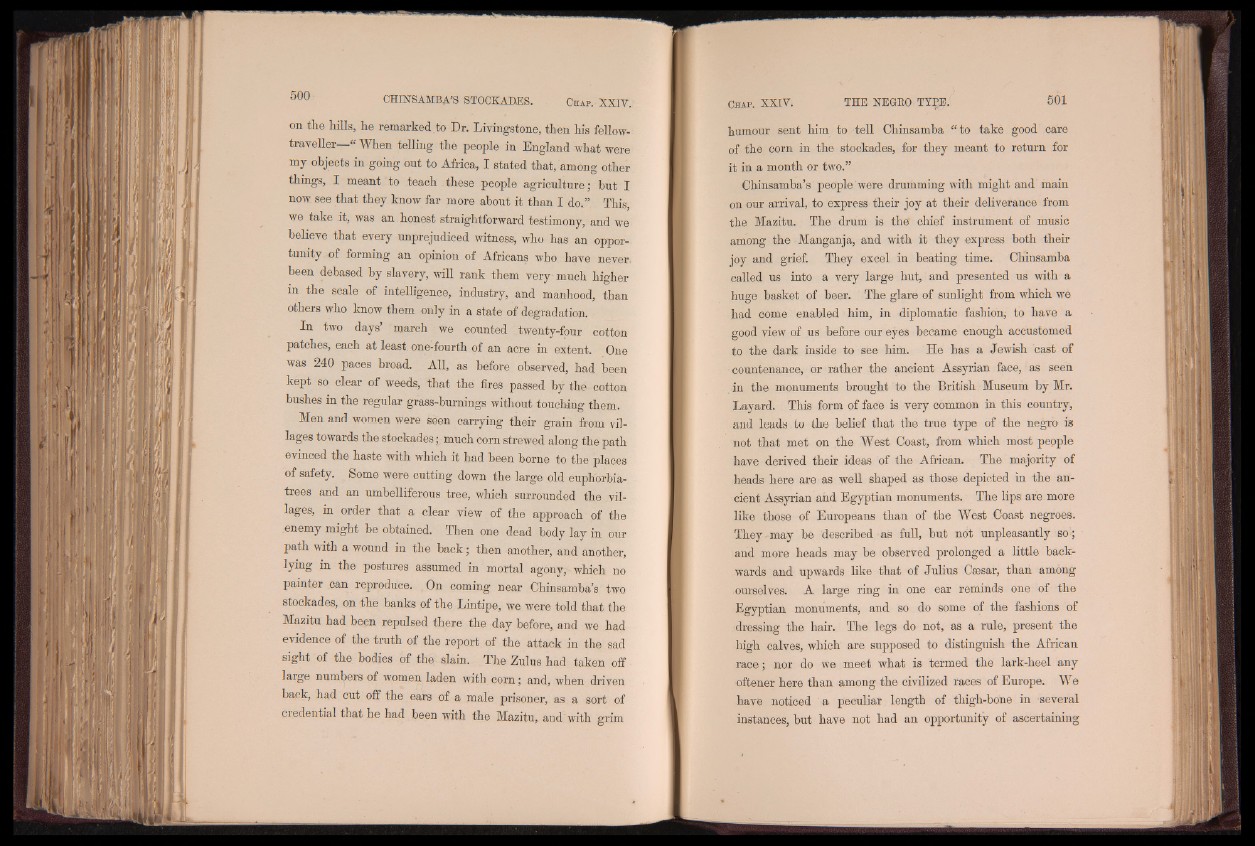
on the hills, he remarked to Dr. Livingstone, then his fellow-
traveller “ When telling the people in England what were
my objects in going out to Africa, I stated that, among other
things, I meant to teach these people agriculture; but I
now see that they know far more about it than I do.” This,
we take it, was an honest straightforward testimony, and we
believe that every unprejudiced witness, who has an opportunity
of forming an opinion of Africans who have never,
been debased by slavery, will rank them very much higher
in the scale of intelligence, industry, and manhood, than
others who know them only in a state of degradation.
In two days’ march we counted twenty-four cotton
patches, each at least, one-fourth of an acre in extent. One
was 240 paces broad. All, as before observed, had been
kept so clear of weeds, that the fires passed by the cotton
bushes in the regular grass-bumings without touching them.
Men and women were seen carrying their grain from villages
towards the stockades; much corn strewed along the path
evinced the haste with which it had been borne to the places
of safety. Some were cutting down the large old euph'orbia-
trees and an umbelliferous tree, which surrounded the villages,
in order that a clear view of the approach of the
enemy might be obtained. Then one dead body lay in our
path with a wound in the back; then another, and another,
.lying in the postures assumed in mortal agony, which no
painter can reproduce. , On coming near Chinsamba’s two
stockades, on the banks of the Lintipe, we were told that the
Mazitu had been repulsed there the day before, and we had
evidence of the truth of the report of the attack in the sad
sight of the bodies of the slain. The Zulus had taken off
large numbers of women laden with corn; and, when driven
back, had cut off the ears of a male prisoner, as a sort of
ciedential that he had been with the Mazitu, and with grim
humour sent him to tell Chinsamba “ to take good care
of the corn in the stockades, for they meant to return for
it in a month or two.”
Chinsamba’s people were drumming with might and main
on our arrival, to express their joy at their deliverance from
the Mazitu. The drum is the chief instrument of music
among the Manganja, and with it they express both their
joy and grief. They excel in beating time. Chinsamba
called us into a very large hut, and presented us with a
huge basket of beer. The glare of sunlight from which we
had come enabled him, in diplomatic fashion, to have a
good view of us before our eyes became enough accustomed
to the dark inside to see him. He has a Jewish cast of
countenance, or rather the ancient Assyrian face, as seen
in the monuments brought to the British Museum by Mr.
Layard. This form of face is very common in this country,
and leads to the belief that the true type of the negro is
not that met on the West Coast, from which most people
have derived their ideas of the African. The majority of
heads here are as well shaped as those depicted in the ancient
Assyrian and Egyptian monuments. The lips are more
like those of Europeans than of the West Coast negroes.
They may be described as full, but not unpleasantly so ;
and more heads may be observed prolonged a little backwards
and upwards like that of Julius Caesar, than among
ourselves. A large ring in one ear reminds one of the
Egyptian monuments, and so do some of the fashions of
dressing the hair. The legs do not, as a rule, present the
high calves, which are supposed to distinguish the African
race; nor do we meet what is termed the lark-heel any
oftener here than among the civilized races of Europe. We
have noticed a peculiar length of thigh-bone in several
instances, but have not had an opportunity of ascertaining